Moreno La Quatra
DeepDialogue: A Multi-Turn Emotionally-Rich Spoken Dialogue Dataset
May 26, 2025Abstract:Recent advances in conversational AI have demonstrated impressive capabilities in single-turn responses, yet multi-turn dialogues remain challenging for even the most sophisticated language models. Current dialogue datasets are limited in their emotional range, domain diversity, turn depth, and are predominantly text-only, hindering progress in developing more human-like conversational systems across modalities. To address these limitations, we present DeepDialogue, a large-scale multimodal dataset containing 40,150 high-quality multi-turn dialogues spanning 41 domains and incorporating 20 distinct emotions with coherent emotional progressions. Our approach pairs 9 different language models (4B-72B parameters) to generate 65,600 initial conversations, which we then evaluate through a combination of human annotation and LLM-based quality filtering. The resulting dataset reveals fundamental insights: smaller models fail to maintain coherence beyond 6 dialogue turns; concrete domains (e.g., "cars," "travel") yield more meaningful conversations than abstract ones (e.g., "philosophy"); and cross-model interactions produce more coherent dialogues than same-model conversations. A key contribution of DeepDialogue is its speech component, where we synthesize emotion-consistent voices for all 40,150 dialogues, creating the first large-scale open-source multimodal dialogue dataset that faithfully preserves emotional context across multi-turn conversations.
Exploring Generative Error Correction for Dysarthric Speech Recognition
May 26, 2025Abstract:Despite the remarkable progress in end-to-end Automatic Speech Recognition (ASR) engines, accurately transcribing dysarthric speech remains a major challenge. In this work, we proposed a two-stage framework for the Speech Accessibility Project Challenge at INTERSPEECH 2025, which combines cutting-edge speech recognition models with LLM-based generative error correction (GER). We assess different configurations of model scales and training strategies, incorporating specific hypothesis selection to improve transcription accuracy. Experiments on the Speech Accessibility Project dataset demonstrate the strength of our approach on structured and spontaneous speech, while highlighting challenges in single-word recognition. Through comprehensive analysis, we provide insights into the complementary roles of acoustic and linguistic modeling in dysarthric speech recognition
"KAN you hear me?" Exploring Kolmogorov-Arnold Networks for Spoken Language Understanding
May 26, 2025



Abstract:Kolmogorov-Arnold Networks (KANs) have recently emerged as a promising alternative to traditional neural architectures, yet their application to speech processing remains under explored. This work presents the first investigation of KANs for Spoken Language Understanding (SLU) tasks. We experiment with 2D-CNN models on two datasets, integrating KAN layers in five different configurations within the dense block. The best-performing setup, which places a KAN layer between two linear layers, is directly applied to transformer-based models and evaluated on five SLU datasets with increasing complexity. Our results show that KAN layers can effectively replace the linear layers, achieving comparable or superior performance in most cases. Finally, we provide insights into how KAN and linear layers on top of transformers differently attend to input regions of the raw waveforms.
MVP: Multi-source Voice Pathology detection
May 26, 2025Abstract:Voice disorders significantly impact patient quality of life, yet non-invasive automated diagnosis remains under-explored due to both the scarcity of pathological voice data, and the variability in recording sources. This work introduces MVP (Multi-source Voice Pathology detection), a novel approach that leverages transformers operating directly on raw voice signals. We explore three fusion strategies to combine sentence reading and sustained vowel recordings: waveform concatenation, intermediate feature fusion, and decision-level combination. Empirical validation across the German, Portuguese, and Italian languages shows that intermediate feature fusion using transformers best captures the complementary characteristics of both recording types. Our approach achieves up to +13% AUC improvement over single-source methods.
Bilingual Dual-Head Deep Model for Parkinson's Disease Detection from Speech
Mar 13, 2025
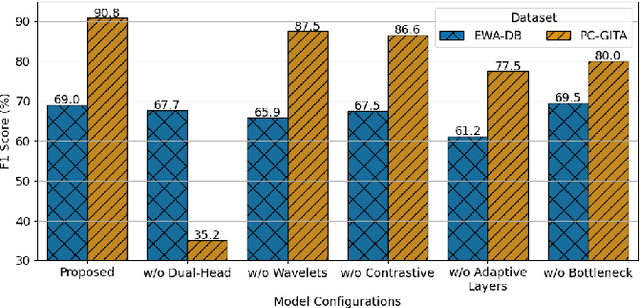
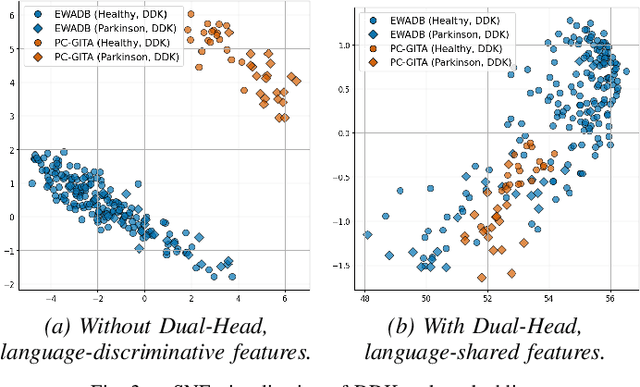
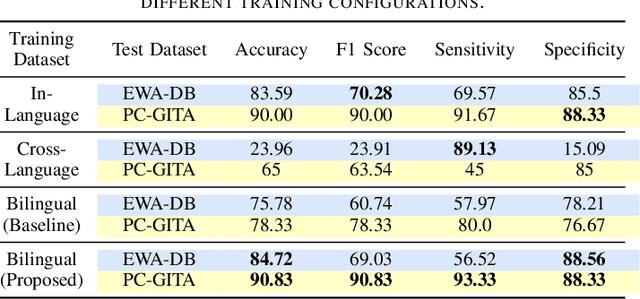
Abstract:This work aims to tackle the Parkinson's disease (PD) detection problem from the speech signal in a bilingual setting by proposing an ad-hoc dual-head deep neural architecture for type-based binary classification. One head is specialized for diadochokinetic patterns. The other head looks for natural speech patterns present in continuous spoken utterances. Only one of the two heads is operative accordingly to the nature of the input. Speech representations are extracted from self-supervised learning (SSL) models and wavelet transforms. Adaptive layers, convolutional bottlenecks, and contrastive learning are exploited to reduce variations across languages. Our solution is assessed against two distinct datasets, EWA-DB, and PC-GITA, which cover Slovak and Spanish languages, respectively. Results indicate that conventional models trained on a single language dataset struggle with cross-linguistic generalization, and naive combinations of datasets are suboptimal. In contrast, our model improves generalization on both languages, simultaneously.
voc2vec: A Foundation Model for Non-Verbal Vocalization
Feb 22, 2025



Abstract:Speech foundation models have demonstrated exceptional capabilities in speech-related tasks. Nevertheless, these models often struggle with non-verbal audio data, such as vocalizations, baby crying, etc., which are critical for various real-world applications. Audio foundation models well handle non-speech data but also fail to capture the nuanced features of non-verbal human sounds. In this work, we aim to overcome the above shortcoming and propose a novel foundation model, termed voc2vec, specifically designed for non-verbal human data leveraging exclusively open-source non-verbal audio datasets. We employ a collection of 10 datasets covering around 125 hours of non-verbal audio. Experimental results prove that voc2vec is effective in non-verbal vocalization classification, and it outperforms conventional speech and audio foundation models. Moreover, voc2vec consistently outperforms strong baselines, namely OpenSmile and emotion2vec, on six different benchmark datasets. To the best of the authors' knowledge, voc2vec is the first universal representation model for vocalization tasks.
Exploiting Consistency-Preserving Loss and Perceptual Contrast Stretching to Boost SSL-based Speech Enhancement
Aug 08, 2024Abstract:Self-supervised representation learning (SSL) has attained SOTA results on several downstream speech tasks, but SSL-based speech enhancement (SE) solutions still lag behind. To address this issue, we exploit three main ideas: (i) Transformer-based masking generation, (ii) consistency-preserving loss, and (iii) perceptual contrast stretching (PCS). In detail, conformer layers, leveraging an attention mechanism, are introduced to effectively model frame-level representations and obtain the Ideal Ratio Mask (IRM) for SE. Moreover, we incorporate consistency in the loss function, which processes the input to account for the inconsistency effects of signal reconstruction from the spectrogram. Finally, PCS is employed to improve the contrast of input and target features according to perceptual importance. Evaluated on the VoiceBank-DEMAND task, the proposed solution outperforms previously SSL-based SE solutions when tested on several objective metrics, attaining a SOTA PESQ score of 3.54.
Exploiting Foundation Models and Speech Enhancement for Parkinson's Disease Detection from Speech in Real-World Operative Conditions
Jun 23, 2024



Abstract:This work is concerned with devising a robust Parkinson's (PD) disease detector from speech in real-world operating conditions using (i) foundational models, and (ii) speech enhancement (SE) methods. To this end, we first fine-tune several foundational-based models on the standard PC-GITA (s-PC-GITA) clean data. Our results demonstrate superior performance to previously proposed models. Second, we assess the generalization capability of the PD models on the extended PC-GITA (e-PC-GITA) recordings, collected in real-world operative conditions, and observe a severe drop in performance moving from ideal to real-world conditions. Third, we align training and testing conditions applaying off-the-shelf SE techniques on e-PC-GITA, and a significant boost in performance is observed only for the foundational-based models. Finally, combining the two best foundational-based models trained on s-PC-GITA, namely WavLM Base and Hubert Base, yielded top performance on the enhanced e-PC-GITA.
Speech Analysis of Language Varieties in Italy
Jun 22, 2024
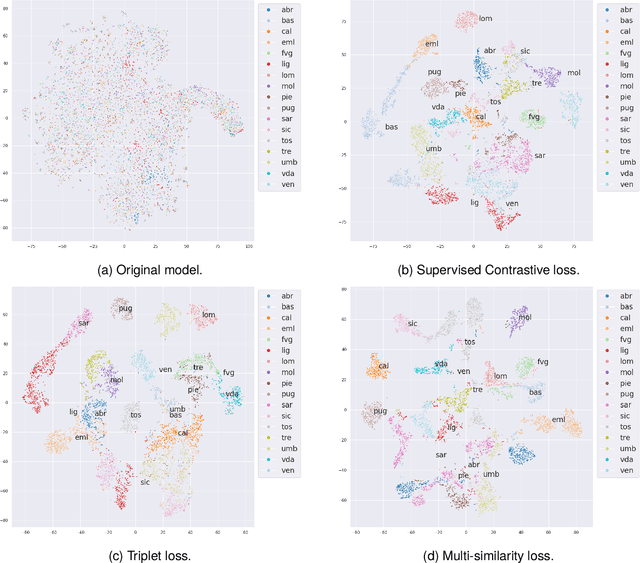

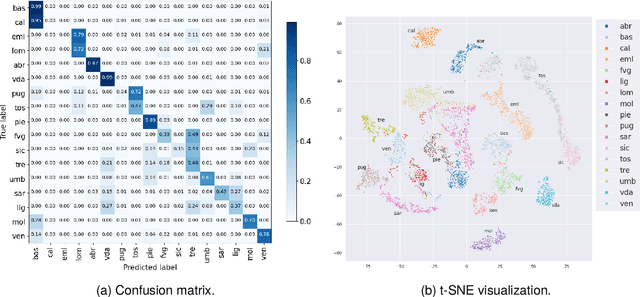
Abstract:Italy exhibits rich linguistic diversity across its territory due to the distinct regional languages spoken in different areas. Recent advances in self-supervised learning provide new opportunities to analyze Italy's linguistic varieties using speech data alone. This includes the potential to leverage representations learned from large amounts of data to better examine nuances between closely related linguistic varieties. In this study, we focus on automatically identifying the geographic region of origin of speech samples drawn from Italy's diverse language varieties. We leverage self-supervised learning models to tackle this task and analyze differences and similarities between Italy's regional languages. In doing so, we also seek to uncover new insights into the relationships among these diverse yet closely related varieties, which may help linguists understand their interconnected evolution and regional development over time and space. To improve the discriminative ability of learned representations, we evaluate several supervised contrastive learning objectives, both as pre-training steps and additional fine-tuning objectives. Experimental evidence shows that pre-trained self-supervised models can effectively identify regions from speech recording. Additionally, incorporating contrastive objectives during fine-tuning improves classification accuracy and yields embeddings that distinctly separate regional varieties, demonstrating the value of combining self-supervised pre-training and contrastive learning for this task.
An Investigation of Incorporating Mamba for Speech Enhancement
May 10, 2024



Abstract:This work aims to study a scalable state-space model (SSM), Mamba, for the speech enhancement (SE) task. We exploit a Mamba-based regression model to characterize speech signals and build an SE system upon Mamba, termed SEMamba. We explore the properties of Mamba by integrating it as the core model in both basic and advanced SE systems, along with utilizing signal-level distances as well as metric-oriented loss functions. SEMamba demonstrates promising results and attains a PESQ score of 3.55 on the VoiceBank-DEMAND dataset. When combined with the perceptual contrast stretching technique, the proposed SEMamba yields a new state-of-the-art PESQ score of 3.69.
 Add to Chrome
Add to Chrome Add to Firefox
Add to Firefox Add to Edge
Add to Edge